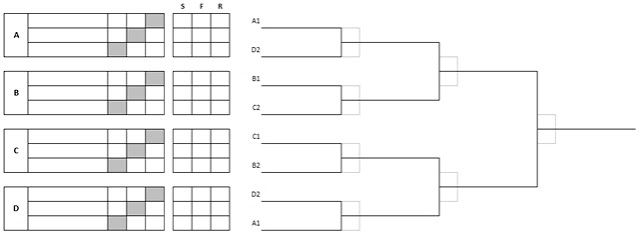CONTACT Form

RULES & REGULATIONS
- 大会の本則
Taikai Rules
The regulation of the matches will follow “The Rules and Regulations of Iaido Shiai and Shinpan”, published by the FIK, as closely as possible.
Participant Qualifications
- (a) Every competitor must be a member, in good standing, of the Canadian Kendo Federation
- (b) Every competitor must be a member of a dojo, in good standing, of the Canadian Kendo Federation
- (c) Every competitor must be at least 16 years old at the time of the Championship
- (d) Every competitor must wear an official nafuda/zekken showing clearly the name of the competitor and their province.
- (e) Every competitor must be a Canadian citizen, landed immigrant, or permanent resident.
Referee Qualifications
- (a) Appointment of Referees of the Canadian National Iaido Championship is entrusted to the Canadian Kendo Federation with assistance from the All Japan Kendo Federation.
- (b) The function of a Referee is incompatible with that of a Coach or Manager.
Manager
The Manager for a dojo is responsible for the behaviour and attitude of the dojo members and for the correct way of handling and wearing their equipment. All complaints are to be brought up to the dojo Manager for resolution with the Tournament Director and the CKF/AJKF representatives.
Drawing
The drawing will be held under the authority of the CKF prior to the event. Competitors are seeded based on their results and participation in past tournaments in Canada and around the world.
Format
Individual National Championship
Competitors can be male or female, and represent the province of the Iaido dojo they are a member of. Competitors must have the exact grade of the following categories in which they participate at the time of the competition. Individuals compete 1-on-1 while performing the same prescribed forms (Shitei Waza).
- 2-Dan and below will be assigned five (5) Seitei forms
- 3-Dan and above will perform one Koryu kata of their choosing, plus four (4) assigned Seitei forms.
The match time shall be 6 minutes for 5 forms, including opening and closing reiho. The player who receives more flags than the other by the judgement of the Referees will be considered the winner.
Divisions:
- 1. Mudan (kyu/no rank)
- 2. Shodan (1st dan)
- 3. Nidan (2nd dan)
- 4. Sandan (3rd dan)
- 5. Yondan (4th dan)
- 6. Godan (5th dan) + Above
TEAMS
Team Composition
Teams will consist of three (3) participants who are also registered in the individual matches. The combined ranks of the team members must be no more than 10-Dans.
For example: A 4-Dan + 4-Dan + 2-Dan = 10-Dans is permitted, however, a 5-Dan + 4-Dan + 2-Dan = 11-Dans is not.
Team Matches
A team match will consist of three consecutive 1-on-1 matches between members of each team. The first competitor (Senpo) will face the Senpo of the other team, the middle competitor (Chuken) will face the Chuken of the other team, and the final competitor, or captain (Taisho) will face the Taisho of the other team.
All competitors will perform the same three (3) assigned Seitei forms, after which the Referees will select a winner by show of flags. The team with at least two (2) winners out of the three matches will be considered the winning team. Senpo will be the only member who performs opening reiho, and Taisho will be the only member who performs closing reiho.
The match time will be decided on the day of the event.
JUDGING POINTS
The following points should be considered when deciding victory:
- Depth of practice
- Etiquette (correct attitude, manners)
- Technique:
- Correct NUKITSUKE, KIRITSUKE
- Correct SAYABANARE, HASUJI
- Correct CHIBURI, angle
- Correct NOTO
- Mental attitude:
- Calmness
- METSUKE (looking)
- Spirit, ZANSHIN (alertness)
- timing, distance
- KI-KEN-TAI-ITCHI
- IAIDO should be rational as BUDO
- Reference is made to "Points to look for in Refereeing and Examinations of ZNKR IAI" -- in the ZNKR manual.
REGULATIONS
Safety:
Safety is of the utmost importance when using Iaito and Shinken:
- Pay attention not to injure yourself
- Pay attention not to injure others
- Pay attention not to create situations that may cause injuries to yourself and others
Participants under the rank of 4 Dan must not practice without supervision.
Participants of the CNIC may only practice in designated areas.
Etiquette:
Inherent in all budo is the concept of etiquette (rei) and respect. As practitioners of these traditional martial arts, it is our responsibility to exhibit proper manners and attitude. This means:
- Silence – When Sensei is speaking, be quiet. Do not chat with others.
- Listen – When Sensei is speaking, do not practice. Keep your sword in the saya with thumb on tsuba.
- Gratitude – Show your appreciation to everyone at the seminar, as we all share the same passion.
- Greetings – Whenever you pass the Sensei or they pass you, acknowledge them with a bow.
- Stay Alert – Be proactive in helping the Sensei with things such as opening doors, carrying items, bringing water, etc.
- Seiza – When you are allowed to sit, try SEIZA as much as possible. If you need to leave seiza posture, please do so discretely.
- Dojo – Respect the cleanliness of the dojo, wear shoes/zouri when not on the dojo floor and keep your belongings tidy.
Sword
Only proper iaito and shnken are permitted. The sword must be inspected prior to the match to ensure all of the following points:
- 1. There should be no damage on the Tsuka or the Sword when checked top to bottom and side to side.
- 2. Tsuba and Habaki should not move even when you press them.
- 3. Mekugi should be properly fitted, not loose, and should not be outside of Tsukamaki
- 4. There should be absolutely no damage on Kissaki and Monouchi.
- 5. Saya and Koiguchi should not be cracked (reinforced with tape would not be acceptable).
If any one of the points listed above are not met, it must fixed, or you will not be authorized to participate.
To verify that your sword has been inspected, you must receive the initial of one of the designated inspectors.
Attire
An Iaido or Kendo gi and hakama shall be worn. The hakama and gi should be the same colour of black, dark blue, or white. Proper name tags are required and should be attached to the left chest. No jewellery is permitted. Tie or pin your hair if necessary so it does not cover your eyes.
The back, front and sides of the gi should not bulge, nor should the back of the neckline stick out. The neckline at the front should meet close to the base of the throat and should not loosen or come apart during practice. T-shirts may not be worn but an under-gi (juban) is permissable. The gi must be long enough to cover the leg at the side of the hakama.
Tabi are only allowed under unusual circumstances and with permission of the Referee Director. The obi usually matches the colour of the hakama. Sageo must be used at all Dan levels of competition.
Physical Ailments
Medical conditions that require extra attire (not mentioned above), or that the kata be modified (i.e. standing rather than seiza) must be indicated in a doctor's note.

